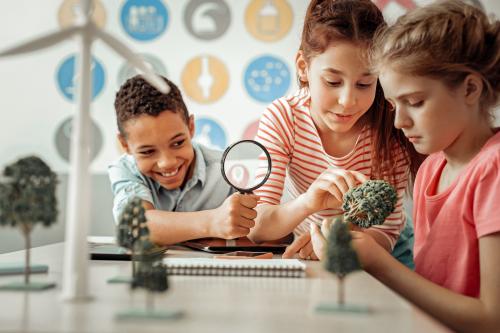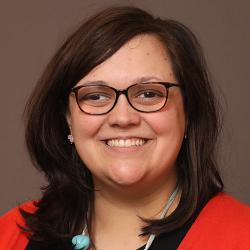“Shhhhhh.” This is perhaps the sound most associated with libraries. Yet, libraries are also portals to the world outside that take us to faraway places and spur new ideas. Libraries offer community gathering spaces where neighbors without internet access can complete job applications and families can gather for story time. But as times have changed, so has the vision, function, and form of the library. Libraries are also becoming community spaces that support children’s development.
Our 2017 blog post “Lessons from Ben Franklin” outlined an innovative project with the goal of creating play spaces in branches of the Free Library of Philadelphia. As researchers who spearheaded the Playful Learning Landscapes initiative, we are committed to infusing public spaces with playful learning opportunities that naturally enhance children’s cognitive and social development, better equipping them with the skills needed to succeed in a changing world. A library is an ideal place to enhance with playful learning opportunities. Not only are libraries community hubs, but they inspire wonder, curiosity, and creativity. Shelves, tables, and rooms come alive with chances for dramatic play. Consider a blank wall in the library. Reimagine it as a surface where children can climb on letters to create new words. And think about chairs that double as tangram puzzles as a place to curl up and read, all nested within the library shelves.
The results of this ambitious Play-and-Learn Spaces project—just published in the journal Library & Information Science Research—involved a novel collaboration between designers, community organizations, and researchers who hoped to push the envelope on how the children’s area in library spaces might be more responsive to the needs of families.
These changes in design morphed the library from “shhh” to a vibrant interactive family learning center.
Funded by the William Penn Foundation, the project featured incredible designs from DIGSAU and Studio Ludo. Researchers from Playful Learning Landscapes worked with the team to create play spaces in three different branches of the Free Library. Discussions and collaboration with branch librarians, Studio Ludo, and Smith Memorial Playground ensured culturally sensitive and community responsive designs. In those collaborations, the team 1) observed staff reactions to users engaging with a variety of nontraditional materials in the library; 2) helped library patrons of all ages envision and articulate the kind of space they would like to play and learn in; and 3) synthesized feedback and observations into a menu of design features or schemes.
Each feedback session offered a range of options so that families could share their vision through coloring sheets, large-scale tempera paintings on a wall, or an actual stretch of shelving in the library. Library patrons gathered to share the kinds of spaces they would like to have in their neighborhoods. A vision board asked visitors to identify or explore their preferences using images from extant innovative libraries, meeting spaces, or other creative arts spaces. Other library patrons jumped into activities like building and painting in the space to show how they would like their libraries to look. During activities, facilitators took note of families’ behaviors as well as librarians’ reactions to activities that may have seemed rowdy, messy, or otherwise difficult to manage. And mindful of the community input, the children’s section of each library emerged anew. The tangram-type seating, complete with magnetic words, along with a new stage, came to life.
These changes in design morphed the library from “shhh” to a vibrant interactive family learning center. Caregivers and children started talking more, filling the air with new vocabulary words. Children climbed walls as they spelled a new word and used more numbers and spatial terms—a foundation for later learning in science, technology, engineering, and mathematics (STEM). As an added bonus, children put their smartphones and tablets down in favor of interacting with each other and their caregivers. Why is this so important? Scientists have long known that good reading and math scores are born from rich language skills supported through interactions between caregivers and children that spark high quality conversations.
This project is but one from the broader Playful Learning Landscapes initiative. Across projects, the scientific evidence is mounting: Meeting families in their communities and changing everyday spaces like libraries, bus stops, and supermarkets into learning zones impacts all who visit these spaces. By inviting conversation and playful interaction, “playbraries” transform the “shhhhs” of children’s libraries into vibrant neighborhood hubs infused with the science of learning frequented by an engaged community.
Photo credit of Cecil B. Moore Library Play-and-Learn space: Free Library of Philadelphia
Note: This work was supported by a grant from The William Penn Foundation through Temple University as part of the Philadelphia Playful Learning Landscapes Initiative. The opinions expressed in this report are those of the authors and do not necessarily reflect the views of The William Penn Foundation and Temple University.
The Brookings Institution is committed to quality, independence, and impact.
We are supported by a diverse array of funders. In line with our values and policies, each Brookings publication represents the sole views of its author(s).









Commentary
Playbrary: A new vision of the neighborhood library
February 20, 2020